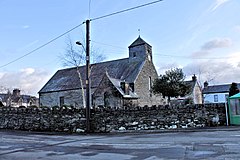Pennal
This articleneeds additional citations forverification.(March 2023) |
| Pennal | |
|---|---|
 St Peter ad Vincula church, Pennal | |
Location withinGwynedd | |
| Population | 404 (2011)[1] |
| OS grid reference | SH699003 |
| Community |
|
| Principal area | |
| Preserved county | |
| Country | Wales |
| Sovereign state | United Kingdom |
| Post town | Machynlleth |
| Postcode district | SY20 |
| Dialling code | 01654 |
| Police | North Wales |
| Fire | North Wales |
| Ambulance | Welsh |
| UK Parliament | |
| Senedd Cymru – Welsh Parliament | |
Pennalis a village andcommunityon theA493 roadin southernGwynedd,Wales, on the north bank of theRiver Dyfi,nearMachynlleth.
It lies in thehistoric countyofMerionethshire(Welsh:Sir Feirionnydd) and is within theSnowdonia National Park.
Roman fort
[edit]It was the site of a smallRoman fort,known as Cefn Caer inWelsh,[clarification needed]probably guarding a ford or ferry crossing of the Dyfi on theSarn HelenRoman road.The remains of the fort lie under the 14th-century house of Cefn Caer, overlooking the village.
Price Family of Esgair Weddan
[edit]Just outside Pennal is the farmstead of 'Esgair Weddan' which from the 14th century until the mid 18th was the home of the Price (ap Rhys) family of Esgair Weddan, patrilineal descendants ofDafydd ap Llywelyn,son ofLlywelyn fawr(the great) Prince of Wales (1240–1246). Their home was called Plas yn y Rofft in Elizabethan times and was located in a field behind the present farmhouse above the village of Cwrt, (originally Pont y Cwrt), meaning "court", near toMynydd Esgairweddan.[citation needed]
Owain Glyndŵr
[edit]Pennal is known for its historical association withOwain Glyndŵr.In Pennal Owain composed thePennal Letterof 1406, a letter tothe King of Francesetting out his plans for an independent Wales – the only document which stands as a policy document for an independent Wales in the Middle Ages. The letter was briefly returned to Wales from France for an exhibition at theNational Library of Walesin 2000, and a campaign has started for it to be returned permanently to Wales and be put on show at theNational Assemblybuilding inCardiff.[citation needed]
Anwyl Family of Llugwy
[edit]Just outside Pennal, on the banks of the Dyfi opposite the hamlet ofMorben,is "Llugwy",the home of theAnwyl familysince 1682. This family havepatrilinear descentfromRhodri Mawrthrough Anarawd, his eldest son, andOwain Gwynedd(king ofGwyneddc.1137 – 1170) to the present day.[citation needed]
Recent history
[edit]In the early 19th century there were quays on the Dyfi whereslatefrom the quarries aroundCorris,AberllefenniandAbergynolwynwas brought by packhorse for loading onto seagoing vessels. This trade died out when theCorris Railwayto Machynlleth and theTalyllyn RailwaytoTywynwere built. TheCwm Ebol quarryoperated a mile north west of the village between 1868 and around 1906. A3 ft(914 mm) gauge tramway[2](later converted to2 ft(610 mm) gauge) operated between the quarry and the village. Between 1918 and 1920 part of the tramway was reused in another2 ft(610 mm) gauge railway, serving timber felling operations at Cwm Dwr, two miles north of the village. The early internal combustion locomotiveBaguley 774was used on the line.[3]
The village also has a place in music history, as it was at nearbyBron-Yr-Aurcottage thatRobert Plantwas living when he wrote theLed Zeppelinclassic, "Stairway to Heaven".[citation needed]
References
[edit]- ^"Community population 2011".Retrieved14 May2015.
- ^Richards, Alun John (2001).The Slate Railways of Wales(1st. ed.). Llanrwst, Wales: Gwasg Carreg Gwalch.ISBN0-86381-689-4.
- ^Quine, Dan(March 2017). "Baguley 774 and the Pennal Tramway".Industrial Railway Record.


